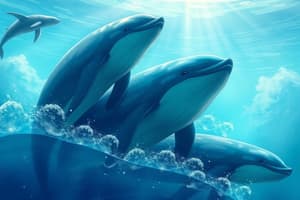Podcast
Questions and Answers
What is the function of the melon in toothed whales?
What is the function of the melon in toothed whales?
- To filter food through baleen
- To emit/send sound waves out (correct)
- To store oxygen for deep diving
- To protect the brain
Which type of whales use baleen to trap food?
Which type of whales use baleen to trap food?
- Toothed whales
- Narwhals
- Beluga whales
- Baleen whales (correct)
What is apneustic breathing?
What is apneustic breathing?
- A type of breathing used by baleen whales
- A breathing technique that allows marine mammals to hold their breath for longer periods of time
- A series of breaths taken at the surface before submerging to dive (correct)
- A type of breathing that involves taking in oxygen through the skin
What is myoglobin and how is it used by marine mammals?
What is myoglobin and how is it used by marine mammals?
What is the Marine Mammal Protection Act?
What is the Marine Mammal Protection Act?
What are some adaptations marine mammals have to prevent body heat loss?
What are some adaptations marine mammals have to prevent body heat loss?
What is the main difference between seals and sea lions?
What is the main difference between seals and sea lions?
What is the Exclusive Economic Zone (EEZ) according to the Law of the Sea?
What is the Exclusive Economic Zone (EEZ) according to the Law of the Sea?
What is the consequence of by-catch in fishing?
What is the consequence of by-catch in fishing?
What is the main purpose of Marine Protected Areas (MPA's)?
What is the main purpose of Marine Protected Areas (MPA's)?
Flashcards are hidden until you start studying
Study Notes
Marine Mammals and Pinnipeds: Characteristics, Adaptations, and Differences
- All cetaceans have a blowhole; toothed whales have one, while baleen whales have up to two.
- The melon is an organ that allows toothed whales to emit/send sound waves out, and it can be of different sizes.
- Echolocation is a sonar system present only in toothed whales, which allows them to sense objects in water and navigate, find food, detect prey, communicate, and attract/find a mate.
- Baleen is a keratin plate that suspends from the mouths of some whales, used by filter-feeding whales to trap food like krill and fish in their baleen before swallowing it.
- Myoglobin is a muscle protein that stores oxygen, used by marine mammals for deep diving.
- Apneustic breathing is a series of breaths taken at the surface before submerging to dive, inhaling and exhaling at the surface.
- The Marine Mammal Protection Act of 1972 is a federal law that protects all marine mammal populations, making it illegal to kill them without a permit, take samples, or approach them within 100 yards.
- Marine mammals have basic characteristics such as large bodies, endothermy, hair-covered skin, viviparity, mammary glands, no cloaca, few well-cared-for offspring, well-developed brain, and protection by the Marine Mammal Protection Act.
- Adaptations to prevent body heat loss in marine mammals include a streamlined body, major muscles on the body trunk, dense layers of hair and/or blubber, and limiting the amount of warm blood flow to the skin.
- Pinnipeds include seals, sea lions, and walruses, which share some similarities such as being great swimmers, having a body shape that allows movement on land, hauling out, living in cold waters, and feeding on fish and squid.
- Seals have short necks, rounded snouts, no external ear flaps, and swim with large hind flippers for propulsion, while sea lions have elongated/larger fore flippers, small external ear flaps, and swim with large pectoral/fore flippers.
- Walruses are the only pinniped with tusks, which are used to find food and help them pull their bodies up on the ice, and they feed on marine invertebrates like clams and mud. Hawaiian monk seals are threatened by entanglement from lost/rogue fishing gear.
Studying That Suits You
Use AI to generate personalized quizzes and flashcards to suit your learning preferences.




